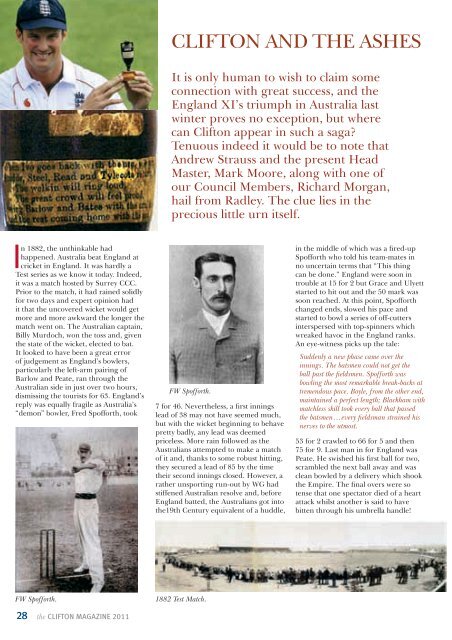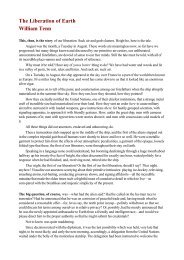Old_Cliftonian_Mag_2011
Old_Cliftonian_Mag_2011
Old_Cliftonian_Mag_2011
You also want an ePaper? Increase the reach of your titles
YUMPU automatically turns print PDFs into web optimized ePapers that Google loves.
CLIFTON AND THE ASHES<br />
It is only human to wish to claim some<br />
connection with great success, and the<br />
England XI’s triumph in Australia last<br />
winter proves no exception, but where<br />
can Clifton appear in such a saga?<br />
Tenuous indeed it would be to note that<br />
Andrew Strauss and the present Head<br />
Master, Mark Moore, along with one of<br />
our Council Members, Richard Morgan,<br />
hail from Radley. The clue lies in the<br />
precious little urn itself.<br />
In 1882, the unthinkable had<br />
happened. Australia beat England at<br />
cricket in England. It was hardly a<br />
Test series as we know it today. Indeed,<br />
it was a match hosted by Surrey CCC.<br />
Prior to the match, it had rained solidly<br />
for two days and expert opinion had<br />
it that the uncovered wicket would get<br />
more and more awkward the longer the<br />
match went on. The Australian captain,<br />
Billy Murdoch, won the toss and, given<br />
the state of the wicket, elected to bat.<br />
It looked to have been a great error<br />
of judgement as England’s bowlers,<br />
particularly the left-arm pairing of<br />
Barlow and Peate, ran through the<br />
Australian side in just over two hours,<br />
dismissing the tourists for 63. England’s<br />
reply was equally fragile as Australia’s<br />
“demon” bowler, Fred Spofforth, took<br />
FW Spofforth.<br />
7 for 46. Nevertheless, a first innings<br />
lead of 38 may not have seemed much,<br />
but with the wicket beginning to behave<br />
pretty badly, any lead was deemed<br />
priceless. More rain followed as the<br />
Australians attempted to make a match<br />
of it and, thanks to some robust hitting,<br />
they secured a lead of 85 by the time<br />
their second innings closed. However, a<br />
rather unsporting run-out by WG had<br />
stiffened Australian resolve and, before<br />
England batted, the Australians got into<br />
the19th Century equivalent of a huddle,<br />
in the middle of which was a fired-up<br />
Spofforth who told his team-mates in<br />
no uncertain terms that “This thing<br />
can be done.” England were soon in<br />
trouble at 15 for 2 but Grace and Ulyett<br />
started to hit out and the 50 mark was<br />
soon reached. At this point, Spofforth<br />
changed ends, slowed his pace and<br />
started to bowl a series of off-cutters<br />
interspersed with top-spinners which<br />
wreaked havoc in the England ranks.<br />
An eye-witness picks up the tale:<br />
Suddenly a new phase came over the<br />
innings. The batsmen could not get the<br />
ball past the fieldsmen. Spofforth was<br />
bowling the most remarkable break-backs at<br />
tremendous pace. Boyle, from the other end,<br />
maintained a perfect length; Blackham with<br />
matchless skill took every ball that passed<br />
the batsmen…every fieldsman strained his<br />
nerves to the utmost.<br />
53 for 2 crawled to 66 for 5 and then<br />
75 for 9. Last man in for England was<br />
Peate. He swished his first ball for two,<br />
scrambled the next ball away and was<br />
clean bowled by a delivery which shook<br />
the Empire. The final overs were so<br />
tense that one spectator died of a heart<br />
attack whilst another is said to have<br />
bitten through his umbrella handle!<br />
FW Spofforth.<br />
28 the CLIFTON MAGAZINE <strong>2011</strong><br />
1882 Test Match.



